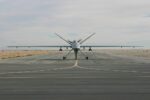The U.S. Air Force is upgrading its F-15EX Eagle II fleet with a new radar system that promises significantly extended detection range without increasing power consumption. The new Raytheon-built AN/APG-82(V)2 Active Electronically Scanned Array (AESA) radar is designed to improve tracking performance, reduce maintenance demands, and enhance survivability in contested airspace—all while fitting into the existing aircraft infrastructure.
Raytheon’s AN/APG-82(V)2: A Next-Step Evolution in AESA Technology
The AN/APG-82(V)2 radar represents a major evolutionary step from the current APG-82(V)1 system used on legacy F-15E Strike Eagles. While it retains the same form factor and interfaces to ensure backward compatibility and ease of integration into the F-15EX platform, it incorporates a new GaN-based transmitter-receiver module (TRM) architecture. This allows for increased radiated power efficiency and thermal management without requiring additional aircraft cooling or electrical upgrades.
According to Raytheon officials, the new radar offers “significantly greater range” than its predecessor, although exact figures remain classified. The APG-82(V)1 already provided notable improvements over mechanically scanned arrays (MSAs), including faster target acquisition and multi-target tracking. The V(2)’s enhancements are expected to further improve detection of low-observable targets at extended ranges—critical in modern peer-adversary scenarios involving stealth aircraft or long-range cruise missiles.
Maintaining Power Envelope While Boosting Performance
A key design objective for the APG-82(V)2 was achieving performance gains without exceeding the existing power draw limits of legacy systems. This constraint is particularly important for airframes like the F-15EX that are derived from older designs but expected to operate in high-end threat environments.
Raytheon achieved this by leveraging Gallium Nitride (GaN)-based semiconductors in its TRMs. GaN provides higher breakdown voltage and better thermal conductivity compared to Gallium Arsenide (GaAs), enabling more efficient RF output per module while reducing heat generation. This translates into a longer mean time between failure (MTBF), lower life-cycle costs, and more reliable operation during extended missions.
The radar also benefits from software-defined architecture, allowing future upgrades via software patches rather than hardware swaps—an increasingly critical feature as electronic warfare threats evolve rapidly.
Integration Timeline and Production Outlook
The U.S. Air Force has already begun integrating the APG-82(V)2 into early production lots of the F-15EX Eagle II under Boeing’s ongoing contract for up to 104 aircraft. According to statements made at recent defense industry events such as AFA Warfare Symposium 2024, initial radars are undergoing flight testing as part of developmental test campaigns at Eglin Air Force Base.
Boeing confirmed that Lot 3 production aircraft will include the new radar baseline by default. Earlier lots may receive retrofits depending on operational timelines and funding availability through USAF modernization budgets such as RDT&E lines or Foreign Military Sales offsets.
This timeline aligns with broader USAF goals of fielding 24 combat-coded F-15EXs by FY2025—a schedule driven by urgent needs to replace aging F‑15C/D airframes that lack structural life margin or modern avionics for near-peer conflict scenarios.
Operational Implications for Air Superiority Missions
The enhanced radar capability directly supports the F‑15EX’s role as an advanced air superiority platform capable of carrying large missile loads—including up to 12 AIM‑120 AMRAAMs or combinations involving AIM‑260 JATM once available. With greater detection range, pilots can exploit beyond visual range (BVR) engagements more effectively while maintaining standoff distance against enemy integrated air defense systems (IADS).
- Improved situational awareness: Wider field-of-regard scanning with faster refresh rates supports better target discrimination in cluttered environments.
- Multi-role flexibility: The APG‑82(V)2 enables simultaneous air-to-air and air-to-ground targeting modes with higher fidelity SAR mapping capabilities.
- Electronic protection: Enhanced LPI/LPD features reduce detectability by adversary receivers while maintaining high-resolution tracking data.
Together with other upgrades like EPAWSS (Eagle Passive/Active Warning Survivability System), IRST pods, and Link 16 enhancements, the new radar positions the F‑15EX as a formidable node in joint all-domain command-and-control networks (JADC2).
AESA Radar Trends Across Fighter Fleets
The APG‑82(V)2 reflects broader trends across U.S. fighter modernization programs emphasizing AESA radar upgrades across multiple platforms:
- F/A‑18E/F Super Hornet: Upgraded with Raytheon’s APG‑79 AESA system offering similar GaN-based improvements.
- F‑16V Viper: Lockheed Martin integrates Northrop Grumman’s SABR AESA radars under service life extension programs (SLEPs).
- F‑22 Raptor: Undergoing phased upgrades including processor refreshes for its AN/APG‑77 AESA system amid NGAD transition planning.
This convergence toward modular AESA architectures reflects both threat-driven requirements—such as counter-stealth capabilities—and sustainment imperatives like reduced maintenance hours per flight hour (MH/FH). For fourth-generation fighters like F‑15EX operating alongside fifth-gen assets such as F‑35s or B‑21s, sensor parity is essential for networked lethality against peer adversaries like China or Russia.
A Strategic Investment Amidst Great Power Competition
The decision to equip all future F‑15EX aircraft with upgraded radars underscores USAF priorities amid intensifying great-power competition dynamics. As Indo-Pacific scenarios demand long-range sensors paired with heavy weapons payloads across vast maritime domains, platforms like Eagle II—with its unmatched missile carriage capacity—are seen as complementary force multipliers alongside stealthier assets tasked with penetrating strike roles.
The APG‑82(V)2 thus plays a pivotal role not only tactically but strategically—ensuring that legacy-derived platforms remain relevant through smart sensor modernization investments that extend their utility deep into future operating environments marked by contested electromagnetic spectrum operations and anti-access/area denial (A2/AD) threats.








